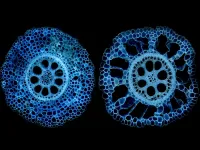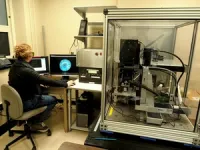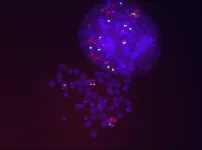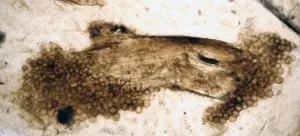(Press-News.org) UNIVERSITY PARK, Pa. — A new discovery, reported in a global study that encompassed more than a decade of research, could lead to the breeding of corn crops that can withstand drought and low-nitrogen soil conditions and ultimately ease global food insecurity, according to a Penn State-led team of international researchers.
In findings published March 16 in the Proceedings of the National Academy of Science, the researchers identified a gene encoding a transcription factor – a protein useful for converting DNA into RNA – that triggers a genetic sequence responsible for the development of an important trait enabling corn roots to acquire more water and nutrients.
That observable trait, or phenotype, is called root cortical aerenchyma and results in air passages forming in the roots, according to research team leader Jonathan Lynch, distinguished professor of plant science. His team at Penn State has shown that this phenotype makes roots metabolically cheaper, enabling them to explore the soil better and capture more water and nutrients from dry, infertile soil.
Now, identifying the genetic mechanism behind the trait creates a breeding target, noted Lynch, whose research group in the College of Agricultural Sciences has been studying root traits in corn and beans in the United States, Asia, Latin America, Europe and Africa for more than three decades, with the aim of improving crop performance.
This latest research was spearheaded by Hannah Schneider, formerly a doctoral student and then postdoctoral scholar in the Lynch lab, now assistant professor of crop physiology at Wageningen University & Research, Netherlands. In the study, she used powerful genetic tools developed in previous research at Penn State to accomplish “high-throughput phenotyping” to measure characteristics of thousands of roots in a short time.
Employing technologies such as Laser Ablation Tomography and the Anatomics Pipeline, along with genome-wide association studies, she found the gene — a “bHLH121 transcription factor” — that causes corn to express root cortical aerenchyma. But locating and then validating the genetic underpinnings of the root trait required a prolonged effort, Schneider pointed out.
“We first performed the field experiments that went into this study starting in 2010, growing more than 500 lines of corn at sites in Pennsylvania, Arizona, Wisconsin and South Africa,” she said. “I worked at all those locations. We saw convincing evidence that we had located a gene associated with root cortical aerenchyma.”
But proving the concept took a long time, Schneider related. The researchers created multiple mutant corn lines using genetic manipulation methods such as the CRISPR/Cas9 gene-editing system and gene knockouts to show the causal association between the transcription factor and formation of root cortical aerenchyma.
“It took years not only to create those lines, but also to phenotype them in different conditions to validate the function of this gene,” she said. “We spent 10 years on this, confirming and validating our results, to make sure that this is the gene and the specific transcription factor that controls root cortical aerenchyma formation. Doing this type of work in the field and digging up and phenotyping roots of mature plants was a long process.”
In the paper, the researchers reported that functional studies revealed that the mutant corn line with the bHLH121 gene knocked out and a CRISPR/Cas9 mutant line in which the gene was edited to suppress its function both showed reduced root cortical aerenchyma formation. In contrast, an overexpression line exhibited significantly greater root cortical aerenchyma formation when compared to the wildtype corn line.
Characterization of these lines under suboptimal water and nitrogen availability in multiple soil environments revealed that the bHLH121 gene is required for root cortical aerenchyma formation, according to the researchers. And the overall validation of the bHLH121 gene’s importance in root cortical aerenchyma formation, they propose, provides a new marker for plant breeders to select varieties with improved soil exploration, and thus yield, under suboptimal conditions.
For Lynch, who plans to retire from the Department of Plant Sciences faculty at the end of this year, this research is the culmination of 30 years’ work at Penn State.
“These findings are the result of many people at Penn State and beyond collaborating with us, working over many years,” he said. “We discovered the function of the aerenchyma trait and then the gene associated with it, And, it came about because of technologies that have been devised here at Penn State, such as Shovelomics — digging up roots in the field — Laser Ablation Tomography and Anatomics Pipeline. We put all those together in this work.”
The results are significant, Lynch continued, because finding a gene behind an important trait that's going to help plants have better drought tolerance and better nitrogen and phosphorus capture looms large in the face of climate change.
“Those are super-important qualities — both here in the U.S. and around the world,” he said. “Droughts are the biggest risk to corn growers and are worsening with climate change, and nitrogen is the biggest cost of growing corn, from both a financial and environmental perspective. Breeding corn lines more efficient at scavenging for the nutrient would be a major development.”
Contributing to the research at Penn State were Kathleen Brown, professor of plant stress biology, now retired, Meredith Hanlon, postdoctoral scholar, Department of Plant Science; Stephanie Klein; doctoral student in plant science; and Cody Depew, postdoctoral scholar, Department of Plant Science; and Vai Lor, Shawn Kaeppler and Xia Zhang, Department of Agronomy and Wisconsin Crop Innovation Center, University of Wisconsin; Patompong Saengwilai, Department of Biology, Faculty of Science, Mahidol University, Bangkok, Thailand; Jayne Davis, Rahul Bhosale and Malcolm Bennett, Future Food Beacon and School of Biosciences, University of Nottingham, Loughborough, UK; Aditi Borkar, School of Veterinary Medicine and Science, University of Nottingham, Sutton Bonington, UK.
The U.S. Department of Energy, the Howard G Buffett Foundation, and the U.S. Department of Agriculture’s National Institute of Food and Agriculture supported this research.
END
Discovery of root anatomy gene may lead to breeding more resilient corn crops
Trait results in roots better able to capture more water and nutrients from soil, need less fertilizer, and withstand drought
2023-03-17
ELSE PRESS RELEASES FROM THIS DATE:
New study shows social media content opens new frontiers for sustainability science researchers
2023-03-17
With more than half of the world’s population active on social media networks, user-generated data has proved to be fertile ground for social scientists who study attitudes about the environment and sustainability.
But several challenges threaten the success of what's known as social media data science. The primary concern, according to a new study from an international research team, is limited access to data resulting from restrictive terms of service, shutdown of platforms, data manipulation, censorship and regulations.
The study, published online March ...
East and West Germans show preference for different government systems 30 years on
2023-03-17
Even after 27 years of reunification, East Germans are still more likely to be pro-state support than their Western counterparts, a new study published in the De Gruyter journal German Economic Review finds. Of the sample studied, 48% of respondents from the East said it was the government’s duty to support the family compared to 35% from the West.
The study led by Prof. Nicola Fuchs-Schündeln of Goethe University Frankfurt, Germany builds on her earlier work which evaluated results from the German Socio-Economic Panel, a regular survey of around 15,000 households. The survey has been running in the federal ...
NASA announces future launch for USU-led space weather mission
2023-03-17
NORTH LOGAN, UTAH - NASA has announced that the launch of the Utah State University Space Dynamics Laboratory and College of Science-led Atmospheric Waves Experiment, or AWE, is scheduled for December 2023. The NASA-funded instrument will launch from Cape Canaveral Space Force Station to the International Space Station.
AWE Principal Investigator Michael Taylor from USU’s College of Science leads a team of scientists that will provide new details about how the weather on Earth interacts with, and affects, space weather. To do that, the AWE instrument, measuring about 54 centimeters by 1 meter and weighing less than 57 kilograms, will peer into Earth’s ...
Quantum sensing in outer space: New NASA-funded research will build next-gen tech to better measure climate
2023-03-17
Texas Engineers are leading a multi-university research team that will build technology and tools to improve measurement of important climate factors by observing atoms in outer space.
They will focus on the concept of quantum sensing, which use quantum physics principles to potentially collect more precise data and enable unprecedented science measurements. These sensors could help satellites in orbit collect data about how atoms react to small changes in their environment, and using that to infer the ...
Scientists identify the mechanisms leading to resistance to lung cancer treatment with Sotorasib, the first KRAS inhibitor
2023-03-17
A collaborative study carried out by the groups of Matthias Drosten, principal investigator at the Cancer Research Center (CSIC- University of Salamanca), and Mariano Barbacid, head of the Experimental Oncology group at the CNIO, reveals the mechanisms responsible for the development of tumor resistance to Sotorasib, the first approved inhibitor against the KRAS oncogene.
The study, recently published in the Journal of Clinical Investigation, shows that lung tumor cells can rapidly adapt to this drug by increasing the number of copies of the mutated KRAS gene targeted by the treatment and by increased expression of xenobiotic pathways that limit ...
Fossil site is ‘Rosetta Stone’ for understanding early life
2023-03-17
Fossil site is ‘Rosetta Stone’ for understanding early life
Leading edge technology has uncovered secrets about a world-renowned fossil hoard that could offer vital clues about early life on earth.
Researchers who analysed the 400 million-year-old-cache, found in rural north-east Scotland, say their findings reveal better preservation of the fossils at a molecular level than was previously anticipated.
Fresh scrutiny of the exquisitely preserved treasure trove from Aberdeenshire has enabled scientists to identify the chemical fingerprints of the various organisms within ...
3D-printed revolving devices can sense how they are moving
2023-03-17
Integrating sensors into rotational mechanisms could make it possible for engineers to build smart hinges that know when a door has been opened, or gears inside a motor that tell a mechanic how fast they are rotating. MIT engineers have now developed a way to easily integrate sensors into these types of mechanisms, with 3D printing.
Even though advances in 3D printing enable rapid fabrication of rotational mechanisms, integrating sensors into the designs is still notoriously difficult. Due to the complexity of the rotating parts, sensors are typically embedded manually, after the device has already ...
Tackling gambling harm among Armed Forces veterans
2023-03-17
Swansea University News Release
17 March 2023
£1 million for projects involving Swansea experts to tackle gambling harm among Armed Forces veterans
Research to tackle gambling harm among Armed Forces veterans has received a major boost with three awards, totalling £1 million, for new projects in the field that involve Swansea University experts.
The projects include evaluating a smartphone app for veterans with gambling disorder and PTSD, which is aimed at reducing symptoms,
The three projects ...
Rivers and streams in the Andean Cordillera are hot spots for greenhouse gases emissions
2023-03-17
A new scientific study by researchers from the University of Liège (Belgium) shows that rivers in the Andean mountains contribute 35% and 72% of riverine emissions of carbon dioxide (CO2 ) and methane (CH4 ) in the Amazon basin, the world's largest river. This study is published in the journal Communications Earth & Environment.
Rivers contribute substantially to global emissions of carbon dioxide (CO2) and methane (CH4). The Amazon River, the World's largest river, plays an important role in greenhouse gas (GHG) emissions. It is the largest river on the planet in terms of freshwater flow," explains Alberto Borges, ...
Dual-task walking performance may be an early indicator of accelerated brain aging
2023-03-17
Boston, MA -- Walking is a complex task that is most commonly performed while completing other tasks like talking, reading signs, or making decisions. For most, after the age of 65, such “dual tasking” worsens walking performance and may even cause unsteadiness. Intriguingly, older adults that are more affected by dual tasking are at higher risk of suffering adverse health outcomes, including both falls and dementia.
A new research study published in Lancet Healthy Longevity has reported that the ability to dual task when walking starts to decline by the age of 55, up to a decade before ‘old ...
LAST 30 PRESS RELEASES:
Injectable breast ‘implant’ offers alternative to traditional surgeries
Neuroscientists devise formulas to measure multilingualism
New prostate cancer trial seeks to reduce toxicity without sacrificing efficacy
Geometry shapes life
A CRISPR screen reveals many previously unrecognized genes required for brain development and a new neurodevelopmental disorder
Hot flush treatment has anti-breast cancer activity, study finds
Securing AI systems against growing cybersecurity threats
Longest observation of an active solar region
Why nail-biting, procrastination and other self-sabotaging behaviors are rooted in survival instincts
Regional variations in mechanical properties of porcine leptomeninges
Artificial empathy in therapy and healthcare: advancements in interpersonal interaction technologies
Why some brains switch gears more efficiently than others
UVA’s Jundong Li wins ICDM’S 2025 Tao Li Award for data mining, machine learning
UVA’s low-power, high-performance computer power player Mircea Stan earns National Academy of Inventors fellowship
Not playing by the rules: USU researcher explores filamentous algae dynamics in rivers
Do our body clocks influence our risk of dementia?
Anthropologists offer new evidence of bipedalism in long-debated fossil discovery
Safer receipt paper from wood
Dosage-sensitive genes suggest no whole-genome duplications in ancestral angiosperm
First ancient human herpesvirus genomes document their deep history with humans
Why Some Bacteria Survive Antibiotics and How to Stop Them - New study reveals that bacteria can survive antibiotic treatment through two fundamentally different “shutdown modes”
UCLA study links scar healing to dangerous placenta condition
CHANGE-seq-BE finds off-target changes in the genome from base editors
The Journal of Nuclear Medicine Ahead-of-Print Tip Sheet: January 2, 2026
Delayed or absent first dose of measles, mumps, and rubella vaccination
Trends in US preterm birth rates by household income and race and ethnicity
Study identifies potential biomarker linked to progression and brain inflammation in multiple sclerosis
Many mothers in Norway do not show up for postnatal check-ups
Researchers want to find out why quick clay is so unstable
Superradiant spins show teamwork at the quantum scale
[Press-News.org] Discovery of root anatomy gene may lead to breeding more resilient corn cropsTrait results in roots better able to capture more water and nutrients from soil, need less fertilizer, and withstand drought








